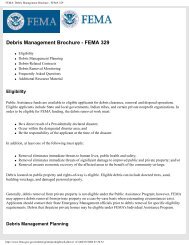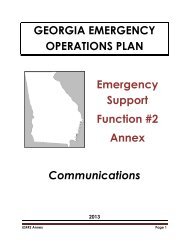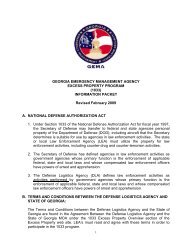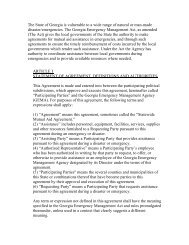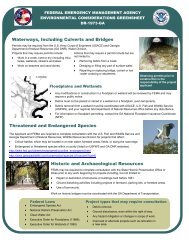Georgia Emergency Operations Plan - GEMA/Homeland Security
Georgia Emergency Operations Plan - GEMA/Homeland Security
Georgia Emergency Operations Plan - GEMA/Homeland Security
Create successful ePaper yourself
Turn your PDF publications into a flip-book with our unique Google optimized e-Paper software.
to survive for greater periods of time and produces rotation in strong<br />
thunderstorms. Finally, <strong>Georgia</strong> is frequently crossed by upper level and surface<br />
features that produce lift and aid in convection.<br />
In 2011 in <strong>Georgia</strong>, there were 948 reports of severe thunderstorm winds; 72<br />
reports of lightning-related incidents; and 67 reports of tornadoes. Note that<br />
these statistics represent just those incidents that have been reported to the<br />
National Weather Service; this actual numbers are likely many times these<br />
amounts.<br />
Tornadoes<br />
<strong>Georgia</strong> usually ranks in the top 15 states in relation to the number of<br />
tornadoes reported each year. Between 1950 and 1994, <strong>Georgia</strong> reported<br />
888 tornadoes, ranking the state 13th in the U.S. with an average of 20 per<br />
year. Although tornadoes have been reported in every month, most occur in<br />
the March to May timeframe. There are also a greater number of tornadoes<br />
reported in the fall from October to November caused by late fall cold fronts.<br />
Although <strong>Georgia</strong> rarely experiences the most devastating EF-4 and EF-5<br />
tornadoes experienced in the Midwest, some have occurred in the past. On<br />
April 25-28, 2011, severe storms moved through the Southeast U.S., producing<br />
large hail, damaging winds, and almost 200 tornadoes. The storms reached<br />
<strong>Georgia</strong> on the evening of April 27th and tracked across the state through<br />
the early morning hours of April 28th, spawning a total of 15 confirmed<br />
tornadoes in <strong>Georgia</strong>. These included six (6) EF-1 tornadoes; three (3) EF-2<br />
tornadoes; five (5) EF-3 tornadoes; and one (1) powerful EF-4 tornado that<br />
devastated portions of northwest <strong>Georgia</strong>. Fifteen storm-related fatalities<br />
were confirmed, and over 500 homes were destroyed.<br />
Lightning<br />
<strong>Georgia</strong> ranks 8 th in the nation for density of lightning strikes per square mile.<br />
Between 2000 and 2007, over 175 people in <strong>Georgia</strong> were injured or killed by<br />
lightning. Lightning strikes that occur from thunderstorms in June, July, and<br />
August are responsible for over half of these injuries and deaths, and over 75%<br />
of property damage annually.<br />
Severe Thunderstorm Winds<br />
Severe thunderstorms in <strong>Georgia</strong> have the potential to cause extensive wind<br />
damage. Straight-line winds can reach speeds of up to 100 mph and<br />
produce damage similar to that of a tornado. These winds occur about 19<br />
days per year in <strong>Georgia</strong> and are most common in the Spring and Summer,<br />
peaking in July. In June 2003, winds from a severe thunderstorm toppled a<br />
250-foot galvanized steel cell phone tower in Dade County.<br />
Hail<br />
Large hail is another threat from severe thunderstorms. Hail causes close to<br />
$1 billion in damage to property and crops each year in the US. While hail is<br />
typically a greater risk for property, the National Oceanic and Atmospheric<br />
Administration estimates that 24 people are injured from hail each year.<br />
<strong>Georgia</strong> <strong>Emergency</strong> <strong>Operations</strong> <strong>Plan</strong> 2013 11 of 71





